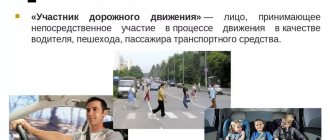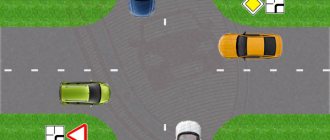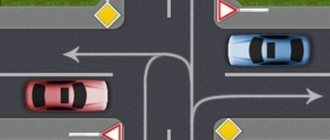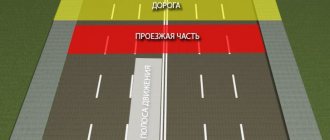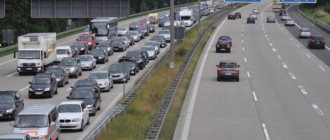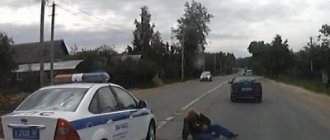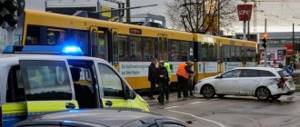Basic traffic rules state that pedestrians must travel on sidewalks, footpaths or cycle paths. If there are none, you can move along the side of the road or along the edge of the roadway. However, if you do not drive a two-wheeled vehicle, including a bicycle, or do not use a wheelchair, then you need to walk exclusively on the left side.
Cross the road at zebra crossings, overpasses and underpasses. It is also possible to carry out this action outside of crossings without endangering your life and the life of the driver, as well as other road users.
As strange as it may sound, the culprits in most accidents in which pedestrians suffer are not drivers, but pedestrian road users. According to statistics from the State Traffic Inspectorate in Moscow, from the beginning of 2021 to the end of November 2021, 1063 accidents occurred due to the fault of pedestrians, in which 126 people died. The logical explanation for such sad statistics is that pedestrians do not know the rules of the road, which means they cannot ensure their safety on the road.
The main aspects for pedestrians are contained in section 4 of the traffic rules. We advise everyone who leaves home to study it carefully and take into account the points where you make mistakes.
So that you don’t have to figure it out yourself, in this article we will tell you in detail how to ensure your safety on the road.
Who are pedestrians according to traffic rules?
According to clause 1.2 of the Traffic Rules, a pedestrian is considered a person who:
1Drives or uses a wheelchair (non-motorized wheelchair).
2Carries a bicycle, sled, motorcycle, cart, or baby stroller.
3 Rides a scooter, skateboard, rollerblades or uses other similar means of transportation.
4Or simply located outside the vehicle.
“Pedestrian” is a person who is outside a vehicle on the road or on a pedestrian or bicycle path and is not working on them. Persons moving in wheelchairs without a motor, driving a bicycle, moped, motorcycle, carrying a sled, cart, baby or wheelchair, as well as using roller skates, scooters and other similar means for movement are considered pedestrians" (hereinafter - traffic rules) .
Persons who participate in road repair work are not considered pedestrians.
Cyclists, drivers of mopeds and motorcycles may, depending on the situation, be guided by the following rules:
- For pedestrians - when driving their vehicle in their hands;
- for drivers - when they drive it.
Pedestrians are full-fledged road users. They are obliged to follow traffic rules in the same way as drivers, if not more scrupulously. After all, unlike drivers, pedestrians are not protected by seat belts and car upholstery, and in the event of an accident they will suffer much more seriously.
Pedestrian or driver? Who is considered a cyclist on the road?
Owners of two-wheeled bikes are often perplexed: why are they required to cross the road on foot at a zebra crossing, like ordinary pedestrians, when they are even given separate lanes on the roads, like drivers?! Motorists sarcastically note that drivers have licenses, but they ride bicycles to do everything, which means that cyclists are pedestrians after all.
The traffic rules clearly state that a cyclist is a person driving a bicycle, and pedestrians are “equated with persons moving in wheelchairs, driving a bicycle,” etc. That is, if you are sitting behind the wheel of a bicycle and pedaling, you are a driver. But if you get off your bike and drive it next to you, you are a pedestrian. And in order to avoid ambiguous interpretations, the traffic rules contain a separate section of rules specifically for cyclists. And it states that a cyclist must cross the road at a pedestrian crossing, and not run over. It is also prohibited for young cyclists under 14 years of age to travel on roads.
Question and answer 10 rules for safe riding for a cyclist. Infographics Adult cyclists are allowed to ride not only on bike paths, but also on the right edge of the roadway. There is no such option - move along the side of the road. And only if there is no curb, you can move along the sidewalk along with pedestrians. Cyclists often wonder whether they are required to let pedestrians pass at a zebra crossing without a traffic light. While you are a driver, you are obligated.
“The popularity of bicycle transport is growing every year, so the State Traffic Inspectorate of the Ministry of Internal Affairs of Russia calls on all lovers of these means of transportation to pay special attention to safety issues, both personal and those of others,” noted the head of the propaganda department of the Main Traffic Safety Inspectorate of the Ministry of Internal Affairs of Russia, police colonel Anton Belan . “It is necessary to know and strictly follow the traffic rules, be sure to use helmets, knee and elbow pads, as well as reflective elements, and regularly check the serviceability of the brake system and the main parts of the bicycle.” Cyclists, in addition, must clearly remember: turning left at intersections if the road is wider than 2 lanes is prohibited. If necessary, you must dismount and cross the road at the zebra crossing.
But you can transport your “iron horse” on public transport – both for a fee and for free. In some cases, you will not be allowed into transport if the bicycle is not disassembled. The main thing is that transporting a bicycle should not cause discomfort to other passengers.
Article on the topic
In a helmet and a bicycle seat. A bicycle is no less dangerous a form of transport than a car. Easy to operate and affordable bicycles have recently become very popular among young people. At the same time, cyclists are the most vulnerable road users: unlike motorists, they can be seriously injured even in the event of a minor accident. A fall at a speed of 10 km/h is enough to break an arm or leg, and if you are not wearing a helmet, to get a traumatic brain injury. According to traffic police accident statistics for 2018, the number of accidents involving collisions with cyclists increased by 7.6% (5294), and the number of victims in them increased by 8.2% (5057). However, the number of deaths in such accidents decreased by 4.9% (370).
By the way, the authorities have been taking care of the comfort of cyclists for several years now. Following the bicycle lanes, bicycle zones will appear on Russian streets. In December, the Russian government introduced amendments to the traffic rules concerning cyclists. In particular, new road signs and markings will appear on the roads. Thus, the signs will provide priority in traffic for cyclists. On the so-called quiet streets, the concept of “Bicycle Zone” has been introduced. The maximum speed in such a zone will be no more than 20 km/h. Pedestrians are allowed to cross the roadway in such a zone in any non-prohibited place. The changes also allow through traffic for cyclists in residential areas.
Where are pedestrians allowed to walk?
Traffic rules allow pedestrians to walk on:
1Sidewalks;
2Pedestrian and bicycle paths.
3Roadsides (if none of the above).
4The edge of the road or bike path (if everything else is missing).
Pedestrians must move on sidewalks, pedestrian paths, bicycle and pedestrian paths, and if there are none, along the sides
clause 4.1
Pedestrians who walk outside the city at night on the side of the road or along the edge of the roadway are required to wear reflectors!
Is it possible to walk on a bike path?
Do not confuse a bicycle pedestrian path with a bicycle path. The first is intended for the movement of both cyclists and pedestrians. The second is only for cyclists. How to distinguish them? The bicycle path is marked with sign 4.4.1, and bicycle and pedestrian paths with signs 4.5.2 - 4.5.7.
Pedestrians are only allowed to walk on a bike path if there is no sidewalk, shoulder or pedestrian path.
If there are no sidewalks, pedestrian paths, bicycle paths or shoulders, or if it is impossible to move along them, pedestrians may use the bicycle path...
Paragraph 2 clause 4.1
Only bicycle drivers are considered cyclists. People who drive (or use) wheelchairs, baby strollers or roller skates should not be on bicycle paths if there is a sidewalk - this is very dangerous.
Traffic rules for cyclists
A common misconception is that “traffic rules for cyclists are only section 24.” But let's remember that section 24 is called “Additional requirements for the movement of cyclists and moped drivers” - feel the difference! These are additional requirements that complement the existing ones.
There is neither time nor, frankly speaking, desire to analyze all the Rules in detail using the example of cyclists. We suggest focusing on typical mistakes.
Where can I go?
First of all, you need to remember Article 24.1.
24.1. Cyclists over 14 years of age must use bicycle paths, bicycle pedestrian paths, or bicycle lanes.
In theory, except on bicycle paths and bicycle lanes, a cyclist should not ride anywhere at all. But this, of course, is a utopia. And there is article 24.2 to help us:
24.2. Cyclists over 14 years of age are allowed:
along the right edge of the roadway - in the following cases:
- there are no bicycle and bicycle pedestrian paths, a lane for cyclists, or there is no opportunity to move along them;
- the overall width of the bicycle, its trailer or the cargo being transported exceeds 1 m;
- cyclists move in columns;
on the side of the road - if there are no bicycle and bicycle pedestrian paths, a lane for cyclists, or there is no opportunity to move along them or along the right edge of the roadway;
on the sidewalk or pedestrian path - in the following cases:
- there are no bicycle and bicycle pedestrian paths, a lane for cyclists, or there is no opportunity to move along them, as well as along the right edge of the roadway or shoulder;
- a cyclist accompanies a cyclist under 7 years of age or transports a child under 7 years of age on an additional seat, in a bicycle stroller or in a trailer designed for use with a bicycle.
This describes the specific priority of choosing, let’s say, the road along which you plan to move. No bike path? Keep strictly to the right edge of the roadway. If this is not possible (the traffic is moving at high speed, for example), then move along the side of the road. And only if there is no curb, you can move along the sidewalk along with pedestrians. Unless, of course, you are carrying a child, then you have nothing to do on the roadway.
And when driving on the sidewalk, you need to remember Article 24.6:
24.6. If the movement of a cyclist on a sidewalk, pedestrian path, shoulder or within pedestrian zones endangers or interferes with the movement of other persons, the cyclist must dismount and follow the requirements provided for by these Rules for the movement of pedestrians.
Should pedestrians pass or not?
In this matter everything is very clear. While you are a driver, all the rules for drivers apply to you. And article 14.1 as well.
14.1. The driver of a vehicle approaching an unregulated pedestrian crossing (the concepts of a controlled and unregulated pedestrian crossing are similar to the concepts of a controlled and unregulated intersection established in paragraph 13.3 of the Rules) is obliged to reduce speed or stop before the crossing in order to allow pedestrians crossing or entering the roadway to pass to make the transition.
How to turn and how to show a turn?
Truly, this is one of the main problems of cyclists on the road.
I would especially like to highlight the following points:
- The "Main Road" sign also applies to cyclists. Just like the “interference on the right” rule, just like traffic lights. There are no exceptions.
- It is prohibited to turn left at intersections if the road is wider than two lanes. There are two options - either circle around the block, turning only to the right, or dismount and cross the road as a pedestrian. Choose for yourself which is easier.
However, even following these notes, problems may arise with the indication of turns. Article 8.1 tells us how to submit them correctly.
8.1. Before starting to move, change lanes, turn (U-turn) and stop, the driver is required to give signals with turn signals in the appropriate direction, and if they are missing or faulty, by hand. When performing a maneuver, there should be no danger to traffic or interference with other road users.
The signal for a left turn (turn) corresponds to the left arm extended to the side or the right arm extended to the side and bent at the elbow at a right angle upward. The right turn signal corresponds to the right arm extended to the side or the left arm extended to the side and bent at the elbow at a right angle upward. The brake signal is given by raising your left or right hand.
Of course, the easiest way to signal a turn is with your arm outstretched - from my own experience, road users notice a hand bent at the elbow much worse. Yes, and it’s not very convenient.
And, of course, you need to remember that signals need to be given in advance.
Do you need lighting devices?
And this question is simply paradise for traffic police officers. There are articles 19.1 and 19.5:
19.1. In the dark and in conditions of insufficient visibility, regardless of the road lighting, as well as in tunnels, the following lighting devices must be turned on on a moving vehicle:
- on all motor vehicles and mopeds - high or low beam headlights, on bicycles - headlights or lanterns, on horse-drawn carts - lanterns (if equipped);
19.5. During daylight hours, all moving vehicles must have low-beam headlights or daytime running lights on to indicate them.
What does this mean in practice? Theoretically, a traffic police officer has the right to stop any cyclist without a light on and issue an administrative violation for violating these articles. How many cyclists use their lights during the day? That's it. And the reflectors won't work.
And, if we are talking about visibility on the road, then we will touch on the topic of “how to become more visible on the road.” In the dark, everything is simple - there is article 24.10:
24.10. When driving at night or in conditions of insufficient visibility, cyclists and moped drivers are recommended to carry items with reflective elements and ensure that these items are visible to drivers of other vehicles.
What to do during the day? Of course, wear bright clothes. The brighter the clothes, the more noticeable you are on the road. However, of course, you shouldn’t get carried away - you, of course, won’t break the rules, but for drivers, some bright pink T-shirt that hurts the eyes can act like a rag on a bull...
What do cyclists mostly violate?
Basically, of course, articles 24.8 and 24.9.
24.8. Cyclists and moped drivers are prohibited from:
- drive a bicycle or moped without holding the handlebars with at least one hand;
- transport cargo that protrudes beyond the dimensions by more than 0.5 m in length or width, or cargo that interferes with control;
- transport passengers if this is not provided for by the design of the vehicle;
- transport children under 7 years of age in the absence of specially equipped places for them;
- turn left or turn around on roads with tram traffic and on roads with more than one lane for traffic in a given direction;
- move on the road without a fastened motorcycle helmet (for moped drivers).
24.9. Towing of bicycles and mopeds, as well as towing with bicycles and mopeds, is prohibited, except for towing a trailer intended for use with a bicycle or moped.
However, other articles of the traffic rules are violated by cyclists a little less often.
Is a helmet required?
The Rules make wearing a helmet mandatory only for drivers of motorcycles and their equivalents. That is, for a cyclist, the absence of a helmet is not a violation of the Rules. However, of course, a helmet will not be superfluous - very different situations happen.
When is a pedestrian allowed to walk on the road?
A pedestrian may walk along the edge of the roadway if:
- He uses a wheelchair and interferes with other pedestrians;
- or carries things that disturb other pedestrians;
- the road is not equipped with a sidewalk, shoulder or path for pedestrians.
Pedestrians carrying or carrying bulky objects, as well as persons using non-motorized wheelchairs, may walk along the edge of the roadway if their movement on sidewalks or shoulders creates an obstacle for other pedestrians. If there are no sidewalks, pedestrian paths, bicycle paths or shoulders, and also if it is impossible to move along them, pedestrians can... walk in a single row along the edge of the roadway (on roads with a dividing strip - along the outer edge of the roadway).
Paragraph 1-2 clause 4.1
On which side of the road you need to walk according to the rules, see the table:
| Which side? | Who? |
| On the right (along the direction of the car) | Disabled people in wheelchairs; Pedestrians with a bicycle/motorcycle in their hands; Organized columns of pedestrians |
| On the left (towards the car) | Other. |
When walking along the edge of the roadway, pedestrians must walk towards the movement of vehicles. Persons moving in wheelchairs without a motor, driving a motorcycle, moped, or bicycle, in these cases must follow the direction of travel of the vehicles.
Paragraph 3 clause 4.1
Traffic rules for pedestrians and cyclists article
Traffic rules for pedestrians and cyclists
Traffic rules for pedestrians.
Pedestrians must move on sidewalks or pedestrian paths, or, if there are none, along the roadsides. If there are no sidewalks, pedestrian paths or shoulders, or if it is impossible to move along them, pedestrians may move along a bicycle path or walk in a single file along the edge of the roadway (on roads with a dividing strip, along the outer edge of the roadway).
When walking along the edge of the roadway, pedestrians must walk towards the movement of vehicles.
When driving along the side of the road or the edge of the roadway in the dark or in conditions of insufficient visibility, pedestrians are recommended to carry objects with reflective elements and ensure that these objects are visible to vehicle drivers.
Groups of children are allowed to drive only on sidewalks and pedestrian paths, and in their absence, along the roadsides, but only during daylight hours and only when accompanied by adults. Pedestrians must cross the roadway at pedestrian crossings, including underground and overground ones, and in their absence, at intersections along sidewalks or curbs. If there is no crossing or intersection in the visibility zone, it is allowed to cross the road at right angles to the edge of the roadway in areas without a dividing strip and fences where it is clearly visible in both directions.
In places where traffic is regulated, pedestrians must be guided by the signals of a traffic controller or a pedestrian traffic light, and in its absence, a transport traffic light. At unregulated pedestrian crossings, pedestrians can enter the roadway after assessing the distance to approaching vehicles, their speed and making sure that the crossing will be safe for them.
When crossing a roadway outside a pedestrian crossing, pedestrians must, in addition, not interfere with the movement of vehicles and exit from behind a standing vehicle or other obstacle that limits visibility without making sure that there are no approaching vehicles.
Once on the roadway, pedestrians should not linger or stop unless this is related to ensuring traffic safety. Pedestrians who do not have time to complete the crossing must stop on the line dividing traffic flows in opposite directions. You can continue crossing only after making sure that further movement is safe and taking into account the traffic light signal (traffic controller)….
In preschool age, a child should cross the street only holding the hand of an adult...
Rule one. Choose a safe place to go. If there is no pedestrian crossing or crossing with a traffic light nearby, choose a place where you can clearly see the road in all directions. Do not try to get onto the road between parked cars. It is important that not only you see the road well, but also that you are clearly visible to any driver. Having chosen a place suitable for crossing, wait and look around.
Rule two. Before crossing, be sure to stop before stepping onto the roadway and carefully inspect the road. You need to stand at the edge of the sidewalk, stepping back a little from the curb - so that you can see the approaching cars.
Rule three. Look around and listen. The car may leave unexpectedly. But if you are careful and keep your ears open, you can hear the car approaching even before it becomes visible. Rule four. If a car is approaching, let it pass, then look around again and listen for other cars nearby. When the car passes, you need to look around again. In the first seconds, she can obscure the car that is driving towards her. Without noticing it, you can fall into a “trap”...
Rule four. If a car is approaching, let it pass, then look around again and listen for other cars nearby. When the car passes, you need to look around again. In the first seconds, she can obscure the car that is driving towards her. Without noticing it, you can fall into a “trap”.
Rule five. Do not enter the roadway until you are sure you have enough time to cross. Only after making sure that you are completely safe, slowly cross the street. Cross it only at right angles.
Rule six. When crossing the street, continue to monitor the road in order to notice a change in the situation in time. The situation on the road changes quickly: cars that were parked can move, those driving straight can turn; new cars may emerge from an alley, from a yard or around a bend
Rule seven. If during the transition there is suddenly an obstacle to your vision (for example, a car has stopped due to a malfunction), carefully looking out from behind it, inspect the rest of the path. Step back if necessary. You need to behave in such a way that you can be clearly seen by passing drivers.
Traffic rules for cyclists
Persons at least 14 years old are allowed to drive a bicycle when driving on roads, and persons at least 16 years old are allowed to drive a moped.
Bicycles and mopeds must move only in the far right lane in one row as far to the right as possible.
Driving on the side of the road is allowed if this does not interfere with pedestrians.
Columns of cyclists must be divided into groups of 10 cyclists. To facilitate overtaking, the distance between groups should be 80 - 100 m.
Bicycle and moped drivers are prohibited from:
- drive without holding the steering wheel with at least one hand;
— carry passengers, except a child under 7 years of age, on an additional seat equipped with reliable footrests;
- transport cargo that protrudes more than 0.5 m in length or width beyond the dimensions, or cargo that interferes with control;
— move along the road if there is a bicycle path nearby;
- turn left or turn around on roads with tram traffic and on roads with more than one lane for traffic in a given direction.
It is prohibited to tow bicycles and mopeds, as well as bicycles and mopeds, except towing a trailer designed for use with a bicycle or moped.
At an unregulated intersection of a bicycle path with a road located outside the intersection, drivers of bicycles and mopeds must give way to vehicles moving on this road.
How to cross the road correctly?
Where can a pedestrian cross the road?
1On an underground or overpass, and in their absence - at intersections along the sidewalks or curbs.
2Zebra crossing (adjustable or unregulated).
3Outside pedestrian crossings (only under special conditions).
We will talk in detail about how to correctly cross the road with or without a zebra crossing in separate paragraphs below. Here we will leave general rules that should be followed regardless of where you cross the road:
- First of all, make sure it is safe to cross the road;
- do not go out onto the road because of buses, trucks, sharp turns and other places where you cannot be seen;
- do not run along the zebra crossing, but also do not move too slowly - this will provoke drivers to pass you;
- If you do not have time to cross, stop on the traffic island or on the line dividing oncoming traffic. Continue walking only when it is safe to do so and only when the traffic light permits;
- if you are a cyclist, carry your bike in your hands at the crossing;
- immediately return to the sidewalk if an ambulance with a siren and blue lights on or any other vehicle giving such a signal appears on the road;
- Cross diagonally only at intersections where there are diagonal zebra crossings. In other places, cross the road only at right angles.
Rules for crossing the road at controlled crossings
If the pedestrian crossing is regulated (there is a traffic light or a traffic controller on it), then cross:
- On the green signal of a special traffic light for pedestrians;
- at a red traffic light for cars.
Important!
Yellow flashing traffic lights at pedestrian crossings do not regulate traffic, but only warn drivers of danger. A regular traffic light has exactly the same meaning if it is turned off and shows only a yellow flashing signal. To cross the road in such places, you should follow the rules for driving on unregulated crossings.
When to cross if there is a traffic controller at the traffic light?
In this case, you need to pay attention only to the traffic controller, regardless of the traffic lights. The traffic controller's gestures and their meanings are specified in clause 6.10 of the traffic rules.
According to the Rules, you can cross the road when:
- The traffic controller stands sideways to you, and his hands are lowered;
- you are behind the traffic controller, and his right arm is extended forward;
- The traffic controller, with a free gesture, indicates to you that you can cross.
Rules for crossing the road at unregulated crossings
If the crossing is not regulated by a traffic light or a traffic controller, then you can go out onto the road only after you are sure that it is safe. A pedestrian, even at a zebra crossing, has no right to throw himself under the wheels of cars and must be careful.
At unregulated pedestrian crossings, pedestrians can enter the roadway (tram tracks) after assessing the distance to approaching vehicles, their speed and making sure that the crossing will be safe for them.
clause 4.5
Who gives way to whom
According to the traffic rules, a cyclist is a vehicle while driving, and therefore must obey traffic signs. Take into account the signals of other vehicles, follow the instructions of traffic lights and traffic controllers.
At an unregulated type of pedestrian crossing, the bike driver is required to let pedestrians pass. In large cities where there are tram lines, the cyclist is also required to give way to pedestrians heading to the tram.
How to cross the road if there is no pedestrian crossing or traffic light?
Traffic regulations allow crossing the road outside crossings if there are none in the visibility zone, but only on the condition that:
1The edge of the road is not fenced and there is no dividing strip on it.
There is no need to climb over fences and then run through 6 lanes to shorten the way home. Drivers on fenced multi-lane roads rely on the common sense of pedestrians and do not expect to see them here at all.
2The road is clearly visible both to the left and to the right.
Do not cross the road behind an incline or around a bend, because of a parked truck, bus or bushes - the driver will not be able to notice you in time and brake.
3You do not interfere with the passage of cars and cross the road only at right angles.
When you cross a road outside of a crossing, cars have priority. Therefore, you must cross it so that moving vehicles do not have to let you pass.
If there is no crossing or intersection in the visibility zone, it is allowed to cross the road at right angles to the edge of the roadway in areas without a dividing strip and fences where it is clearly visible in both directions.
Paragraph 3 p. 4.3
When crossing the road outside a pedestrian crossing, pedestrians, in addition, must not interfere with the movement of vehicles and exit from behind a standing vehicle or other obstacle that limits visibility without making sure that there are no approaching vehicles.
clause 4.5
When crossing the road at night, in rain or fog, be extremely careful, especially on roads outside the city. If you don't wear reflective tape on your clothes, if visibility is limited, the driver can only guess about your existence.
Don’t risk running across, even if it seems to you that the car is very far away. It is very difficult to determine the speed of a car, so it is better to stop and wait until the vehicle passes or make sure that the driver sees you and allows you to pass.
Traffic rules for pedestrians
According to statistics from the State Traffic Safety Inspectorate of the Russian Federation, about 20,000 pedestrians are injured or killed on the roads every year and, in most cases, this happens through their own fault and negligence. The sad fact remains that the participation of children in road accidents with pedestrians is increasing. Such terrifying figures are nothing more than a fact of illiteracy of pedestrians, who, along with other road users (drivers), must know and follow traffic rules for pedestrians, and also teach these rules to their children. There are frequent cases of collisions with cyclists who also do not know or neglect the rules of behavior on the roadway.
Rules for crossing the roadway at an unregulated pedestrian crossing
The definition of “Unregulated pedestrian crossing” means that at this type of crossing there is no traffic light and the driver allows a pedestrian to pass when he steps onto a special roadway marking - a zebra crossing. However, the presence of a crossing does not mean that pedestrians should cross the line of traffic based on their advantage. There are a number of rules for pedestrians included in the traffic rules.
When crossing a roadway, a pedestrian MUST:
- Assess the situation on the road and make sure that moving vehicles are stopped and it is safe to cross.
- Estimate the speed of the flow. If cars are driving too fast, they may not have time to slow down. We will consider the factors influencing this further.
- Cross the roadway only at right angles.
- Take into account weather conditions, in other words visibility.
- Refrain from crossing the roadway when vehicles with blue or red flashing lights and a special sound signal are approaching.
- Remember that on the road it is stupid to prove that you are right, because your life and health depend on it.
Pedestrians are PROHIBITED:
- It is strictly forbidden to cross the roadway
- Step out onto the roadway in front of stopped vehicles
- Linger at the crossing
- Distractions, for example, talking on a mobile phone, listening to music on headphones
- Cross the roadway without looking around and making sure there is no danger
Rules for crossing the roadway for cyclists
Many cyclists who are not familiar with traffic rules believe that their iron friend is a full-fledged motor vehicle, and they have the same rights as other road users (cars, motorcycles). But that's not true! A motor vehicle is a mechanism equipped with a motor, which a bicycle does not have. In cases where the movement of cyclists on the roadway is permitted, this does not mean that they have any advantages on an equal basis with motor vehicles.
When crossing the roadway, a cyclist MUST:
- Drive your bike nearby and never cross the road with it
- Follow all rules for crossing the roadway for pedestrians
Remember: a bicycle is not a motor vehicle, and a cyclist does not follow the rules for motorists and does not take advantage!
How to teach your child traffic rules for pedestrians
First of all, parents should be an example for the child - NEVER break the rules of the crossing, even if you are in a hurry, each of your “dashes” of the pedestrian crossing can cause a tragedy in the future. From an early age, a child must learn traffic rules and get used to always being guided by them.
Every time before crossing the roadway, talk to your child about the rules of behavior on the road, and then let him voice them himself.
Factors that reduce visibility on the road
In certain weather and other conditions, a pedestrian may be noticed late by the driver. All pedestrians should know and remember this!
Rain. When it rains, visibility is noticeably reduced, especially at dusk and at night, when lanterns and headlights are also reflected in puddles. In addition, wet asphalt significantly increases the braking distance.
Snowfall and ice. Snow makes the road very dangerous and during snowfall, before special equipment has time to clear the roadway, you need to be extremely careful.
Fog. Visibility in fog is very low for all road users, both drivers and pedestrians.
Twilight. At dusk, when it is no longer light, but the lights have not yet come on, visibility is quite low, and low beam headlights will not allow you to see a pedestrian in advance.
Dawn and sunset. On a sunny day at dawn and dusk, when the sun is low on the horizon, it can significantly dazzle the driver.
For the safety of yourself and your children in the dark and in poor visibility conditions, the traffic police strongly recommends the use of reflective elements on outer clothing, a bag, a child’s briefcase, in any place where they will be clearly visible to drivers.
Blind area. Pedestrians should be aware that large vehicles (buses, trucks, special equipment) have a “blind spot”, in which the driver simply cannot see the pedestrian. A pedestrian enters this zone when they cross the road too close to a vehicle. At this time, the driver, who does not notice the pedestrian, starts moving and a collision occurs.
You can clearly see how this happens and how NOT to cross the roadway in the video below.
Learn traffic rules and teach your children! May your journey home be safe!
Did you like the article? You can say THANK YOU

